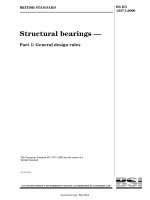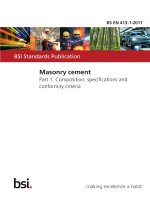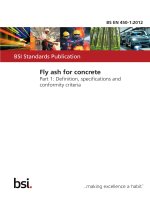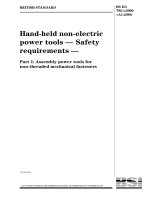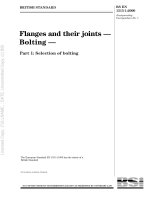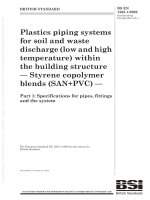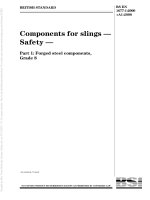Bsi bs en 01337 1 2000
Bạn đang xem bản rút gọn của tài liệu. Xem và tải ngay bản đầy đủ của tài liệu tại đây (575.08 KB, 34 trang )
BRITISH STANDARD
Structural bearings Ð
Licensed copy:PONTYPRIDD COLLEGE, 14/12/2006, Uncontrolled Copy, © BSI
Part 1: General design rules
The European Standard EN 1337-1:2000 has the status of a
British Standard
ICS 91.010.30
NO COPYING WITHOUT BSI PERMISSION EXCEPT AS PERMITTED BY COPYRIGHT LAW
|
|
|
|
|
|
|
|
|
|
|
|
|
|
|
|
|
|
|
|
|
|
|
|
|
|
|
|
|
|
|
|
|
|
|
|
|
|
|
|
|
|
|
|
|
|
|
|
|
|
|
|
|
|
|
|
|
|
|
|
|
|
|
|
|
|
|
|
|
|
|
|
|
|
|
|
|
|
|
|
|
|
|
|
|
|
|
|
|
|
|
|
|
|
|
|
|
|
|
|
|
|
|
|
|
|
|
|
|
|
|
|
|
|
|
|
|
|
|
|
|
|
|
|
|
|
|
|
|
BS EN
1337-1:2000
BS EN 1337-1:2000
National foreword
This British Standard is the official English language version of EN 1337-1:2000.
The UK participation in its preparation was entrusted to Technical Committee
B/522, Structural bearings, which has the responsibility to:
Ð aid enquirers to understand the text;
Ð present to the responsible European committee any enquiries on the
interpretation, or proposals for change, and keep the UK interests informed;
Ð monitor related international and European developments and promulgate
them in the UK.
A list of organizations represented on this committee can be obtained on request to
its secretary.
Licensed copy:PONTYPRIDD COLLEGE, 14/12/2006, Uncontrolled Copy, © BSI
Cross-references
The British Standards which implement international or European publications
referred to in this document may be found in the BSI Standards Catalogue under the
section entitled ªInternational Standards Correspondence Indexº, or by using the
ªFindº facility of the BSI Standards Electronic Catalogue.
A British Standard does not purport to include all the necessary provisions of a
contract. Users of British Standards are responsible for their correct application.
Compliance with a British Standard does not of itself confer immunity
from legal obligations.
Summary of pages
This document comprises a front cover, an inside front cover, the EN title page,
pages 2 to 31 and a back cover.
The BSI copyright notice displayed in this document indicates when the document
was last issued.
This British Standard, having
been prepared under the
direction of the Sector
Committee for Building and Civil
Engineering, was published under
the authority of the Standards
Committee and comes into effect
on 15 October 2000
BSI 10-2000
ISBN 0 580 36540 9
Amendments issued since publication
Amd. No.
Date
Comments
EUROPEAN STANDARD
EN 1337-1
NORME EUROPÉENNE
EUROPÄISCHE NORM
June 2000
ICS 91.010.30
English version
Structural bearings - Part 1: General design rules
Appareils d'appui structuraux - Partie 1: Indications
générales
Lager im Bauwesen - Teil 1: Allgemeine Regelungen
Licensed copy:PONTYPRIDD COLLEGE, 14/12/2006, Uncontrolled Copy, © BSI
This European Standard was approved by CEN on 30 April 2000.
CEN members are bound to comply with the CEN/CENELEC Internal Regulations which stipulate the conditions for giving this European
Standard the status of a national standard without any alteration. Up-to-date lists and bibliographical references concerning such national
standards may be obtained on application to the Central Secretariat or to any CEN member.
This European Standard exists in three official versions (English, French, German). A version in any other language made by translation
under the responsibility of a CEN member into its own language and notified to the Central Secretariat has the same status as the official
versions.
CEN members are the national standards bodies of Austria, Belgium, Czech Republic, Denmark, Finland, France, Germany, Greece,
Iceland, Ireland, Italy, Luxembourg, Netherlands, Norway, Portugal, Spain, Sweden, Switzerland and United Kingdom.
EUROPEAN COMMITTEE FOR STANDARDIZATION
COMITÉ EUROPÉEN DE NORMALISATION
EUROPÄISCHES KOMITEE FÜR NORMUNG
Central Secretariat: rue de Stassart, 36
© 2000 CEN
All rights of exploitation in any form and by any means reserved
worldwide for CEN national Members.
B-1050 Brussels
Ref. No. EN 1337-1:2000 E
Page 2
EN 1337-1:2000
Contents
Page
Licensed copy:PONTYPRIDD COLLEGE, 14/12/2006, Uncontrolled Copy, © BSI
Foreword ...............................................................................................................................................................3
1
Scope.........................................................................................................................................................4
2
Normative references ................................................................................................................................4
3
Definitions and symbols............................................................................................................................5
4
General principles ...................................................................................................................................17
5
Design principles.....................................................................................................................................17
6
Bearing resistances ..................................................................................................................................18
7
Basic design features...............................................................................................................................19
8
Drawing of the support plan....................................................................................................................20
Annex A (informative) Notes for guidance.......................................................................................................21
Annex B (informative) Typical bearing schedule .............................................................................................25
Annex C (informative) Temperature, shrinkage and creep ................................................................................30
Page 3
EN 1337-1:2000
Foreword
This European Standard has been prepared by Technical Committee CEN/TC 167 "Structural bearings", the secretariat of which is
held by UNI.
This European Standard shall be given the status of a national standard, either by publication of an identical text or by
endorsement, at the latest by December 2000, and conflicting national standards shall be withdrawn at the latest by
December 2000.
prEN 1337 "Structural bearings" consists of the following 11 parts:
Part 1 – General design rules
Part 2 – Sliding elements
Part 3 – Elastomeric bearings
Licensed copy:PONTYPRIDD COLLEGE, 14/12/2006, Uncontrolled Copy, © BSI
Part 4 – Roller bearings
Part 5 – Pot bearings
Part 6 – Rocker bearings
Part 7 – Spherical and cylindrical PTFE bearings
Part 8 – Guided bearings and restrained bearings
Part 9 – Protection
Part 10 – Inspection and maintenance
Part 11 – Transport, storage and installation
www.bzfxw.com
This Part 1 "General design" includes Annexes A, B and C (informative).
Further to CEN/TC 167’s decision Part 1 and Part 2 form a package of standards and they come into force together, while
the other parts come into force separately after the publication of Part 1 and Part 2.
According to the CEN/CENELEC Internal Regulations, the national standards organizations of the following countries are bound
to implement this European Standard: Austria, Belgium, Czech Republic, Denmark, Finland, France, Germany, Greece, Iceland,
Ireland, Italy, Luxembourg, Netherlands, Norway, Portugal, Spain, Sweden, Switzerland and the United Kingdom.
Page 4
EN 1337-1:2000
1 Scope
This European Standard is applicable to structural bearings, whether used in bridges or in other structures.
This European Standard does not cover:
a) bearings that transmit moments as a primary function;
b) bearings that resist uplift;
c) bearings for moving bridges;
d) concrete hinges;
e) seismic devices.
Although it is not intended to regulate temporary bearings this standard may be used as a guide in this case (temporary bearings
are bearings used during construction or repair and maintenance of structures).
Licensed copy:PONTYPRIDD COLLEGE, 14/12/2006, Uncontrolled Copy, © BSI
NOTE 1: Although the specifications given in this European Standard are necessary, they are not sufficient in themselves
for the overall design of the structures and for the consideration of geotechnical aspects.
See prEN 1337-2 to prEN 1337-8 for information relating to bearings for which specifications are laid down for certain ranges of
temperature only.
2 Normative references
This European Standard incorporates by dated or undated reference, provisions from other publications. These normative
references are cited at the appropriate places in the text and the publications are listed hereafter. For dated references, subsequent
amendments to or revisions of any of these publications apply to this European Standard only when incorporated in it by
amendment or revision. For undated references the latest edition of the publication referred to applies.
www.bzfxw.com
prEN 1337-2
Structural bearings – Part 2: Sliding elements
prEN 1337-3
Structural bearings – Part 3: Elastomeric bearings
prEN 1337-4
Structural bearings – Part 4: Roller bearings
prEN 1337-5
Structural bearings – Part 5: Pot bearings
prEN 1337-6
Structural bearings – Part 6: Rocker bearings
prEN 1337-7
Structural bearings – Part 7: Spherical and cylindrical PTFE bearings
prEN 1337-8
Structural bearings – Part 8: Guided bearings and restrained bearings
EN 1337-9 : 1997
Structural bearings – Part 9: Protection
prEN 1337-10
Structural bearings – Part 10: Inspection and maintenance
EN 1337-11: 1997
Structural bearings – Part 11: Transport, storage and installation
ENV 1991-1 : 1994
Eurocode 1: Basis of design and actions on structures – Part 1: Basis of design
ENV 1992-2 : 1996
Eurocode 2: Design of concrete structures – Part 2: Concrete bridges
ENV 1993-2 : 1997
Eurocode 3: Design of steel structures – Part 2: Steel bridges
ENV 1994-2 : 1997
Eurocode 4: Design of composite steel and concrete structures – Part 2: Composite bridges
Page 5
EN 1337-1:2000
3 Definitions and symbols
3.1 Definitions
For the purposes of this standard, the following definitions apply:
Ultimate limit state (ULS) and serviceability limit state (SLS) are defined in ENV 1991-1. They apply here in the same way.
3.1.1 bearings: Bearings are elements allowing rotation between two members of a structure and transmitting the loads defined in
the relevant requirements as well as preventing displacements (fixed bearings), allowing displacements in only one direction
(guided bearings) or in all directions of a plane (free bearings) as required.
The most common types of bearings are listed in table 1 and examples of these are are illustrated in figure 1 with the
corresponding axes of coordinates.
A distinction is made between the following categories:
Category 1: All-round rotating bearings
Licensed copy:PONTYPRIDD COLLEGE, 14/12/2006, Uncontrolled Copy, © BSI
Category 2: Bearings with uniaxial rotation
Category 3: Spherical and cylindrical bearings when the horizontal load is supported by the curved sliding surface
Category 4: All other bearings
The bearings of Nos 1.1 to 3.1, 3.3, 3.5 to 4.3, 8.1 and 8.2 belong to category 1.
The bearings of Nos 5.1 to 6.2, 7.3 and 7.4 belong to category 2.
www.bzfxw.com
The bearings of Nos 3.2, 3.4, 7.1 and 7.2 belong to category 3.
Page 6
EN 1337-1:2000
Table 1: Most common types of bearings
1
Relevant parts of the
standard
2
3
No. Symbol in
the plan
view
4
5
Symbol in direction
x
6
Kind of bearing
y
8
9
10
Relative movements
displacements
vy in y- vz in zdirection direction direction
vx in x-
2 3 4 5 6 7 8
X
7
11
12
13
14
Reactions
rotation
=x
=y
=z
about
x-axis
deforming
about
y-axis
deforming
about
z-axis
forces
1.1
Elastomeric bearing (EB)
deform- deforming small2)
ing
none
1
none
1
X
X
1.2
Elastomeric bearing with restraints (RS) for one
axis4)
X X
X
1.3
EB with unidirectional movable sliding part and RS
for the other axis
X X
1.4
Elastomeric bearing with multidirectional movable
sliding part
sliding
and deforming
X X
1.5
Elastomeric bearing with unidirectional movable
sliding part
deforming
sliding
and
deforming
X
X
1.6
Elastomeric bearing with securing device for two
axes
none
X X
X
1.7
Elastomeric bearing with unidirectional movable
sliding part and RS for two axes
sliding
X X
X
1.8
Elastomeric bearing with multidirectional movable
sliding part and RS for two axes
none
moment
Vx Vy N
) Vx Vy N
)
Vy N
www.bzfxw.com
N
deforming
Vy N
1
) Vx Vy N
Vy N
sliding
N
(continued)
Licensed copy:PONTYPRIDD COLLEGE, 14/12/2006, Uncontrolled Copy, © BSI
Page 7
EN 1337-1:2000
Table 1 (continued)
1
Relevant parts of the
standard
2
3
No. Symbol in
the plan
view
4
5
Symbol in direction
x
6
Kind of bearing
y
7
8
9
10
Relative movements
displacements
vy in y- vz in zdirection direction direction
vx in x-
2 3 4 5 6 7 8
X
2.1
Pot bearing
none
X
X
2.2
Pot bearing with unidirectional movable sliding part
sliding
X
X
2.3
Pot bearing with multidirectional movable sliding
part
X
3.1
Spherical bearing with RS beyond the rotating part
none
X
sliding
X
X
3.2
3.3
Spherical bearing with rotating part likewise as RS
Spherical bearing with unidirectional movable sliding
part (ext. guidance)
X
X
3.4
X
X
3.5
Spherical bearing with unidirectional movable sliding
part (int. guidance)
Spherical bearing with multidirectional movable
sliding part
none
very
small
11
12
13
14
Reactions
rotation
=x
=y
=z
about
x-axis
deforming
about
y-axis
deforming
about
z-axis
forces
Vx Vy N
1
Vy N
sliding
and deforming
N
)
sliding
none
moment
www.bzfxw.com
almost
none
sliding
sliding
Vx Vy N
sliding
1
)
Vx Vy N
Vy N
Vy N
sliding
N
(continued)
Licensed copy:PONTYPRIDD COLLEGE, 14/12/2006, Uncontrolled Copy, © BSI
Page 8
EN 1337-1:2000
Table 1 (continued)
1
Relevant parts of the
standard
2
3
No. Symbol in
the plan
view
4
5
Symbol in direction
x
6
Kind of bearing
y
7
8
displacements
vy in y- vz in zdirection direction direction
2 3 4 5 6 7 8
11
=x
=y
about
x-axis
rocking
about
y-axis
rocking
4.1
Steel point rocker bearing
none
none
X
X
4.2
Steel point rocker bearing with unidirectional
movable sliding part
sliding
X
X
4.3
Steel point rocker bearing with multidirectional
movable sliding part
sliding
sliding
X
5.1
Steel linear rocker bearing
none
none
X
X
5.2
Steel linear rocker bearing with unidirectional
movable sliding part
sliding
X
X
5.3
Steel linear rocker bearing with multidirectional
movable sliding part
X
6.1
Single roller bearing
X
6.2
Single roller bearing with sliding part movable in the
other direction
13
14
Reactions
=z
forces
about
z-axis
sliding1) Vx Vy N
moment
Vy N
sliding
rolling
almost
none
12
rotation
vx in x-
X
none
sliding
N
none3)
none
Vx Vy N
Mx
Vy N
Mx
N
Mx
Vy N
Mx
N
Mx
www.bzfxw.com
sliding
none1)
(continued)
Licensed copy:PONTYPRIDD COLLEGE, 14/12/2006, Uncontrolled Copy, © BSI
X
9
10
Relative movements
Page 9
EN 1337-1:2000
Table 1 (concluded)
1
Relevant parts of the
standard
2
3
No. Symbol in
the plan
view
4
5
Symbol in direction
x
6
Kind of bearing
7
y
forces
none
about
x-axis
none3)
about
y-axis
sliding
about
z-axis
none
moment
Vx Vy N
Mx
Vx
N
Mx
Vy N
Mx
N
Mx
X
X
7.2
Guided cylindrical bearing movable in y direction
X
X
7.3
Guided cylindrical bearing movable in x direction
X
X
7.4
Free cylindrical bearing movable in x and y direction
X
8.1
Guide bearing with restraints for two axes = thrust
bearing
none
X
8.2
Guide bearing with restraints for one axis
sliding
none
almost
none
sliding
sliding
none
sliding
none
sliding
sliding sliding or sliding or sliding or Vx Vy
deform- deformdeing
ing
forming
none
Moments
Displacements
Vy
Rotations
For individual types of bearings =z may have strict tolerances, special design will be
necessary if so required. For normal design purposes "none" means no movement
other than that due to manufacturing tolerances and deformation.
Whether or not vz is of importance to be checked in individual cases.
Combination with a sliding bearing results in unfavourable stresses in the PTFE.
Device to transfer the forces Vx or Vy.
NOTE: In practice x is the main direction of movement for bridges (see ENV 1992-2 and ENV 1993-2) and z the direction of the forces due to vertical loads.
Licensed copy:PONTYPRIDD COLLEGE, 14/12/2006, Uncontrolled Copy, © BSI
)
)
4
)
rotation
=z
Fixed cylindrical bearing
3
13
14
Reactions
=y
7.1
2
12
=x
X
Forces
11
vx in x-
X
)
9
10
Relative movements
displacements
vy in y- vz in zdirection direction direction
2 3 4 5 6 7 8
1
8
Licensed copy:PONTYPRIDD COLLEGE, 14/12/2006, Uncontrolled Copy, © BSI
Page 10
EN 1337-1:2000
Figure 1: Examples of the most common types of bearings listed in table 1
Licensed copy:PONTYPRIDD COLLEGE, 14/12/2006, Uncontrolled Copy, © BSI
Page 11
EN 1337-1:2000
Figure 1 (continued): Examples of the most common types of bearings listed in table 1
Licensed copy:PONTYPRIDD COLLEGE, 14/12/2006, Uncontrolled Copy, © BSI
Page 12
EN 1337-1:2000
Figure 1 (continued): Examples of the most common types of bearings listed in table 1
Licensed copy:PONTYPRIDD COLLEGE, 14/12/2006, Uncontrolled Copy, © BSI
Page 13
EN 1337-1:2000
Legend
1
curved surfaces
Figure 1 (continued): Examples of the most common types of bearings listed in table 1
Licensed copy:PONTYPRIDD COLLEGE, 14/12/2006, Uncontrolled Copy, © BSI
Page 14
EN 1337-1:2000
Figure 1 (continued): Examples of the most common types of bearings listed in table 1
Licensed copy:PONTYPRIDD COLLEGE, 14/12/2006, Uncontrolled Copy, © BSI
Page 15
EN 1337-1:2000
Figure 1 (concluded): Examples of the most common types of bearings listed in table 1
3.1.2 support:The support comprises all construction measures including the bearing which serve as a structural member to
transmit forces and allow movements as intended.
3.1.3 bearing system: The bearing system for a structure is the combination of bearings which together provide for the
movements and transmission of forces (see Figure 2).
Page 16
EN 1337-1:2000
Figure 2: Example of a bearing system
3.2 Symbols used in Part 1
3.2.1 Latin upper case letters
Licensed copy:PONTYPRIDD COLLEGE, 14/12/2006, Uncontrolled Copy, © BSI
K
M
N
V
Kelvins
Moment; Bending moment
Axial force
Shear force
3.2.2 Latin lower case letters
n
r
t
v
x
y
z
Number of bearings
Radius
Temperature
Displacement
Longitudinal axis
Transverse axis
Axis normal to the principle bearing surface
3.2.3 Greek letters
a
g
D
m
Coefficient of thermal expansion; factor; rotation
Partial safety factor
Difference; increment
Coefficient of friction
3.2.4 Subscripts
a
c
d
k
l
max
min
p
r
x, y, z
R
S
Adverse
Concrete
Design
Characteristic
Limit value
Maximum
Minimum
Anchorage, fixing device
Relieving; Reversible
Coordinates
Resistance, loadbearing resistance
Internal forces and moments, Stresses
Page 17
EN 1337-1:2000
4 General principles
Bearings and supports shall be designed so that bearings or parts of bearings can be inspected, maintained and replaced if
necessary, in order to enable them to fulfil their function throughout the intended life of the structure.
Bearings shall be designed to permit the specified movement with the minimum possible reacting force.
Presetting shall be avoided as far as possible. If necessary the required presetting shall be carried out at the factory. If readjustment on site cannot be avoided it shall be carried out only by the manufacturer of the bearing or under his supervision.
5 Design principles
5.1 General
Licensed copy:PONTYPRIDD COLLEGE, 14/12/2006, Uncontrolled Copy, © BSI
The design of the various bearings shall be based on serviceability and/or ultimate limit state depending on the safety
classification of the limit state in consideration.
Where characteristic values and partial safety factors for loads and movements are not covered, either by this European
Standard or an Eurocode, the designer shall determine his own values in accordance with the principles set out in ENV 1991-1
and in ENV 1992-2, ENV 1993-2 or ENV 1994-2.
NOTE: A special informative Annex B in ENV 1993-2 deals with bearings.
5.2 Safety against sliding in joints
Where the position of a bearing or part of a bearing is maintained completely or partially by friction its safety against sliding
shall be checked at the ultimate limit state in accordance with the following:
VSd £ VRd
where
VSd
VRd =
is the design shear force resulting from the actions
mk
× N + Vpd
g m Sd
is the design value of shear resistance
with
NSd
minimum design force acting normal to the joint in conjunction with
VSd ;
Vpd
design strength of any fixing device in accordance with European standards or European technical
approvals;
mk
characteristic value of the friction coefficient
Cm
partial safety factor for friction
mk = 0,4 for steel on steel
mk = 0,6 for steel on concrete
C m = 2,0 for steel on steel
C m = 1,2 for steel on concrete
The above-mentioned values of mk and
Cm
shall be used provided that prior to installation or assembly the surfaces of steel
components are un-coated and free from grease or metal-sprayed or coated with fully hardened zinc silicate provided that any
Page 18
EN 1337-1:2000
coating has completely hardened prior to installation or assembly of the components.
In other cases the values for mk and
Cm
shall be established from the results of tests.
In the case of dynamically stressed structures where extreme load fluctuations can occur, e. g. railway bridges and earthquakes,
the horizontal forces shall not be resisted by friction. In these cases mk shall be taken as zero.
Safety against sliding in joints formed by elastomeric bearings without positive means of location shall be checked in
accordance with prEN 1337- 3.
5.3 Conditions of installation
See EN 1337- 11.
Any particular conditions of installation shall be agreed between the purchaser and the manufacturer and shall be confirmed in
writing when the bearings are delivered.
5.4 Increased movements
Licensed copy:PONTYPRIDD COLLEGE, 14/12/2006, Uncontrolled Copy, © BSI
Unless other parts of this European Standard or relevant Eurocodes have more stringent requirements, in order to ensure with
sufficient reliability that bearings do not become unstable, or cease to act as intended, their design movements shall be
increased by the following:
a) rotation
±0,005 radians or ±10/r radians, whichever is the greater, (r measured in millimetres);
b) translation
±20 mm in both directions of movement with a minimum total movement of ±50 mm in the direction of maximum movement
and ±20 mm transversely unless the bearing is mechanically restrained.
These requirements only apply for the design of movements capacities. They shall not be used where stresses are being
calculated. They shall not be applied to elastomeric bearings.
5.5 Minimum movements to be assumed for the strength analysis
For the strength analysis of the bearing the resultant rotational movement shall be taken as not less than ±0,003 radians and
the resultant translational movement as not less than ±20 mm or ±10 mm for elastomeric bearings.
If a bearing cannot rotate about one axis a minimum eccentricity of l /10 perpendicular to that axis shall be assumed. Where l
is the total length of the bearing perpendicular to that axis.
6 Bearing resistances
6.1 General specifications
The values to be used for calculating the resistance to movement of the various types of bearings are given in the relevant parts
of this European Standard. In addition to material variations these values also allow for manufacturing tolerances and
inaccuracies in installation, given in the other Parts of this European Standard. They only hold good if the bearings are not
subjected to any of the following:
a) temperatures above or below the maximum and minimum specified;
b) exceeding of the specified tolerances;
c) greater velocities of translation or rotation than those derived from the live loads according to ENV 1991-1;
d) presence of substances which are harmful to any of the materials in the bearing;
e) insufficient maintenance.
